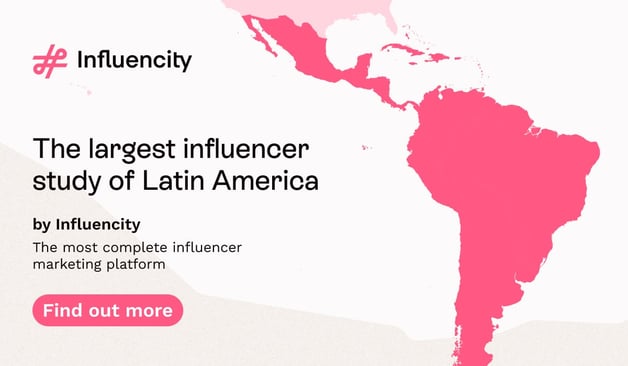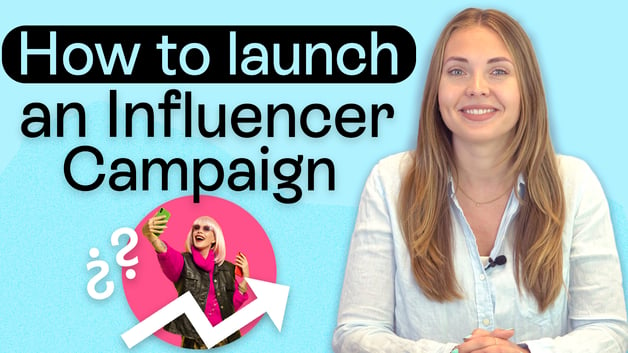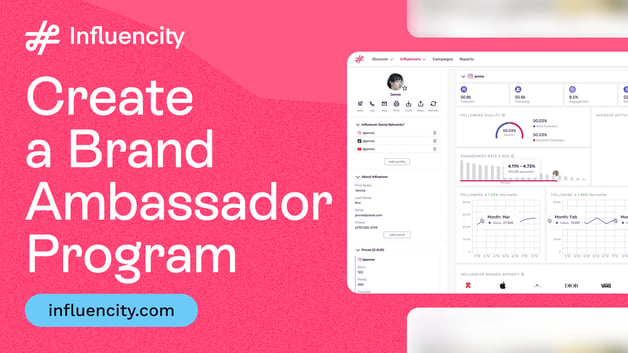Pros and Cons of a Free Influencer Search Tool
The power of influencer marketing is undeniable, yet finding the right influencers to partner with can often feel like searching for a needle in a haystack. That's where an influencer search tool can simplify your search, making the process more efficient and less daunting.
An influencer search tool is a specialized software or platform that helps marketers and businesses find influencers whose followers align with their target audience. These tools vary in complexity and cost, with free influencer search tools providing a basic, cost-effective solution for identifying potential influencers. But do they actually work or are you better off investing in a paid influencer search tool?
This article explores the pros and cons of using a free influencer search tool, helping you decide whether to stick with a free service or invest in a professional platform.
What is an Influencer Search Tool?
Influencer search tools are digital platforms or software that help marketers and brands find and connect with social media influencers whose audience and content align with their marketing goals. These tools streamline the process of identifying influencers who can effectively promote products, services, or brands to their followers.
For example, using Influencity's influencer search tool, marketers can filter influencers based on various criteria such as audience demographics, engagement rates, and niche categories. This allows them to find influencers who best match their target audience and campaign objectives. By using these tools, brands can more efficiently and effectively find and collaborate with influencers, enhancing their marketing strategies and potentially increasing their reach and impact in their target markets.
How does an Influencer Search Tool Work?
Here’s how they typically work:
Search and discovery
Users can search for influencers based on specific criteria such as keywords, topics, demographics, location, engagement rates, and follower count. This makes it easier to find influencers who cater to a specific niche or audience.
For instance, if a brand is looking to promote a new line of fitness products, they can use the search tool to find influencers who frequently post about fitness and health. Entering relevant keywords like "fitness," "workout," or "healthy living," and setting filters for demographics engagement rates, and follower count, brands identify influencers who are most likely to reach and resonate with their target audience.
However, paid influencer search tools normally provide brands with advanced search features to refine their search even further. They can filter by:
- Engagement Rate: Ensuring that the influencers not only have a large following but also active and engaged followers.
- Follower Count: Choosing influencers with a follower count that matches their campaign scale, from micro-influencers to macro-influencers.
- Location: Targeting influencers in specific regions or countries to align with local or regional marketing strategies.
- Topics and Interests: Focusing on influencers who post content related to specific topics or interests that align with the brand’s products or services.
- Brand Affinity: Filter influencers based on their followers’ interest in specific brands or categories, which can indicate a predisposition to similar products.
- Audience Overlap: This filter helps identify influencers whose audiences overlap significantly with other selected influencers, ensuring broader but not redundant reach.
- Content Quality: Evaluate influencers based on the quality of their content, which can be judged by the aesthetics, professionalism, and creativity of their posts.
So, the main differences between free and paid influencer search tools for the discovery are the number of filters and the quality of information they provide. Free tools Generally offer a limited number of filters and basic information, making them suitable for smaller campaigns or initial searches. They provide a cost-effective solution but may lack depth and comprehensive data.
On the other hand, paid tools offer a broader range of filters and access to high-quality, detailed information. They provide advanced analytics, deeper insights and often include additional features like social listening and competitive analysis.
Analytics and insights
These tools provide detailed analytics about potential influencers, including data on their audience demographics, engagement rates, and previous campaign performance. This information helps businesses assess whether an influencer’s followers align with their target market.
Here are some examples of the insights you can get with this type of tool:
- Content Performance: Analysis of how well an influencer's previous posts and campaigns have performed. This includes metrics like reach, impressions, and engagement for specific posts.
- Growth Trends: Insights into the growth of an influencer's follower base over time. This includes tracking the rate at which they gain followers and identifying any sudden spikes or drops. Consistent growth trends are a positive indicator of the influencer's ongoing relevance and appeal.
- Sentiment Analysis: Evaluating the sentiment of comments and interactions on an influencer's posts. This helps businesses understand the overall perception and mood of the influencer's audience towards the content.
- Influencer Activity: Insights into the frequency and consistency of an influencer's posting habits. Regular and consistent posting can indicate an active and engaged influencer, whereas irregular activity might suggest lower engagement levels.
A skincare brand looking to launch a new product line can use these analytics to find the most suitable influencers. For instance, examining the audience demographics, the brand can select influencers whose followers are predominantly women aged 18-34, living in metropolitan areas, and interested in beauty and skincare. Let's say the brand finds that influencer Sarah (@beautybySarah) has an engagement rate of 4.5%, with her followers primarily being young women interested in skincare. Additionally, Sarah's content performance shows that her posts about skincare products consistently receive high engagement, and her follower growth trend is positive. These insights affirm that Sarah would be a valuable partner for the brand's campaign.
Now, the depth and accuracy of analytics and insights can vary significantly between free and paid influencer search tools. Free Tools typically provide basic analytics, such as general follower counts and simple engagement metrics. While useful for initial searches, they may lack the depth needed for thorough campaign planning and decision-making.
However, paid tools offer comprehensive analytics and advanced insights, including detailed audience demographics, sentiment analysis, and in-depth performance metrics. These tools provide businesses with a clearer understanding of an influencer's potential impact, helping them to make more strategic and effective marketing decisions.
Campaign management
Some influencer search tools offer features to manage campaigns, from initial outreach and negotiation to tracking campaign progress and analyzing results. Key components of campaign management in these tools may include:
- Initial Outreach: Tools often provide templates or integrated email systems for reaching out to influencers. This can include automated messages and follow-ups, ensuring timely and professional communication.
- Task Management: Assign tasks to influencers and track their progress. This can include setting deadlines, providing creative briefs, and monitoring content creation. Task management tools help keep campaigns on schedule and ensure that all deliverables are met.
- Content Approval: Platforms may offer content approval workflows, allowing brands to review and approve influencer content before it goes live. This ensures that all content aligns with brand guidelines and campaign objectives.
- Performance Tracking: Real-time tracking of campaign metrics such as engagement rates, reach, impressions, and conversions. This data helps brands monitor the effectiveness of their campaigns and make adjustments as needed.
- Reporting and Analytics: Comprehensive reporting features that provide insights into campaign performance. These reports can be shared with stakeholders and used to evaluate the success of the campaign, providing a basis for future strategies.
The capabilities of campaign management features can differ significantly between free and paid influencer search tools. Free tools can provide basic campaign management features, such as outreach and basic tracking. These tools may be sufficient for small-scale campaigns but may lack the depth and functionality needed for more complex campaigns. Conversely, paid tools offer advanced campaign management features, including detailed management, sophisticated task tracking, content approval workflows, and in-depth performance analytics.
Reporting
After a campaign concludes, influencer search tools can generate detailed reports that provide valuable insights into the campaign’s effectiveness. These reports typically include metrics such as reach, engagement, and return on investment (ROI). This information is crucial for brands to measure the impact of their influencer partnerships and refine future strategies.
The quality and depth of reporting features can vary significantly between free and paid influencer search tools. The former typically offer basic reporting capabilities, such as plain reach and engagement metrics. These tools provide a general overview of campaign performance but may lack detailed insights and advanced analytics. In contrast, paid tools provide advanced reporting features, including in-depth audience demographics, ROI calculations, sentiment analysis, and detailed content performance metrics.
Additional Features
Influencer search tools vary widely in terms of the additional functionalities they offer. Depending on the tool, you can find a range of features designed to streamline the entire influencer marketing process, making it more efficient and effective. Some of these additional features include:
- Payments Management: Some tools offer integrated payment solutions that simplify the process of compensating influencers. This can include features for managing payment schedules, processing transactions in multiple currencies, and keeping track of all financial exchanges, ensuring timely and accurate payments.
- Social Hub: A social hub consolidates all your social media accounts into one central platform. This feature allows you to manage and schedule posts, track social media engagement, and monitor conversations across multiple platforms, all from a single dashboard.
- Monitoring: Advanced monitoring features enable brands to track brand mentions, hashtags, and keywords in real-time across various social media platforms. This helps in gauging public sentiment, identifying trending topics, and responding to customer feedback promptly.
- API Integration: Tools with API integration capabilities allow for seamless connection with other software systems used by your company. This can include CRM systems, analytics platforms, and e-commerce solutions, ensuring that data flows smoothly across all your business applications.
- Contracts Management: Efficiently manage contracts with influencers through tools that offer contract management features. This includes creating, sending, and storing contracts, as well as tracking the status of contract negotiations and ensuring compliance with agreed terms.
Benefits of Using a Free Influencer Search Tool
Free influencer search tools offer a range of advantages that can significantly enhance your marketing strategies. These tools streamline the process of finding the right influencers but they can also help businesses of all sizes to engage with potential brand ambassadors.
Here are some of the key benefits of using free influencer search tools:
1. Cost-Effectiveness
The most obvious benefit of using a free influencer search tool is that it doesn’t require a financial investment. For startups and small businesses with limited budgets, these free tools provide an essential service without the financial strain.
This allows businesses to allocate their resources to other aspects of their marketing strategy or influencer campaigns, making it an economically sound choice for those just beginning to explore the world of influencer marketing.
2. Accessibility and Ease of Use
Free influencer search tools are typically designed with user-friendliness in mind. They offer a straightforward interface that allows even those with minimal technical expertise to search for influencers. This accessibility ensures that businesses can start their influencer marketing campaigns quickly, without the need for extensive training or technical support.
3. Basic functionalities
For many small businesses and individual marketers, a free influencer search tool provides enough functionality to get started. These tools usually allow users to search based on keywords, topics, or demographics, which is often enough to identify relevant influencers for basic campaigns. This can be a great way for businesses to dip their toes into influencer marketing without committing to a significant investment.
Drawbacks of Using a Free Influencer Search Tool
As mentioned previously, free influencer search tools come with their own set of limitations. While they provide essential services without upfront costs, their capabilities can be limited in scope, which can pose challenges for businesses aiming to scale up or broaden their influencer marketing strategies.
Here are some of the drawbacks of using free influencer search tools vs paid solutions:
1. Basic Features and Capabilities
While free influencer search tools offer basic search capabilities, they often lack the advanced features found in paid platforms. Features such as in-depth analytics, historical data access, and more sophisticated search filters are typically reserved for paid platforms. This can limit a business's ability to thoroughly vet influencers and measure the effectiveness of their campaigns, potentially leading to less informed decision-making.
2. Smaller Databases and Reduced Reach
Another significant disadvantage of using a free influencer search tool is that they tend to have limited databases. Paid tools often have access to a larger pool of influencers, including niche and local influencers, which might not be as accessible through free tools. This reduced reach can hinder a business's ability to find the perfect match for its brand, especially if targeting a very specific audience or location.
3. Less Robust Analytics and Support
The analytics provided by free influencer search tools are typically not as comprehensive as those offered by paid services. Advanced analytics are crucial for understanding campaign impact, influencer performance, and audience engagement. Moreover, support options are often limited with free influencer search tools, which can be a significant drawback when immediate assistance or troubleshooting is required.
Which Tool Should I Use?
So, which solution should you choose? Is a free influencer search tool good enough or should you invest in a paid solution?
This will depend on a number of factors, including your business size, budget, marketing goals, and the complexity of the campaigns you intend to run. For those just starting out or working with limited resources, a free influencer search tool might be enough to get a basic understanding of influencer marketing and start building relationships with influencers. However, as your brand grows and your objectives become more sophisticated, a paid platform like Influencity will provide the advanced features and analytics you need to scale up your marketing efforts.
Specifically, a free influencer search tool might be enough for your business if:
- You are just starting with influencer marketing.
- Your marketing budget is significantly restricted.
- You need to learn the basics of building influencer partnerships before scaling up.
However, we recommend investing in a paid influencer search tool like Influencity if:
- Your business is scaling up and you need to manage multiple campaigns.
- You need access to more detailed insights and analytics to optimize campaign performance.
- You need to access a broader network of influencers, including niche and local influencers.
Influencer Search Tools: Summing Up
Influencer search tools have become an indispensable asset for marketers looking to leverage the power of their influencer collaborations. Free influencer search tools simplify the daunting task of identifying and partnering with influencers who can authentically amplify a brand's message to the right audience. The benefits, including cost-effectiveness, ease of use, and basic functionality, make these tools particularly appealing for startups and small businesses venturing into the world of influencer marketing for the first time.
However, it's important to recognize the limitations of free influencer search tools. Limited features, smaller databases, and less detailed analytics can hinder a business's ability to execute a robust influencer marketing strategy. As your business grows and your marketing goals become more complex, you will need access to a more sophisticated solution to continue expanding your marketing efforts effectively.
For those ready to take their influencer marketing to the next level, we recommend Influencity's paid platform. Our comprehensive solution offers not just broader access to influential profiles but also advanced analytics and tailored support to help you optimize your campaigns. By choosing Influencity, you get access to the tools you need to craft impactful, data-driven influencer strategies that drive engagement and deliver measurable results.
Tags:






















%20and%20How%20Can%20They%20Benefit%20Your%20Brand%20article.jpg?length=628&name=What%20Are%20Key%20Opinion%20Leaders%20(KOL)%20and%20How%20Can%20They%20Benefit%20Your%20Brand%20article.jpg)








